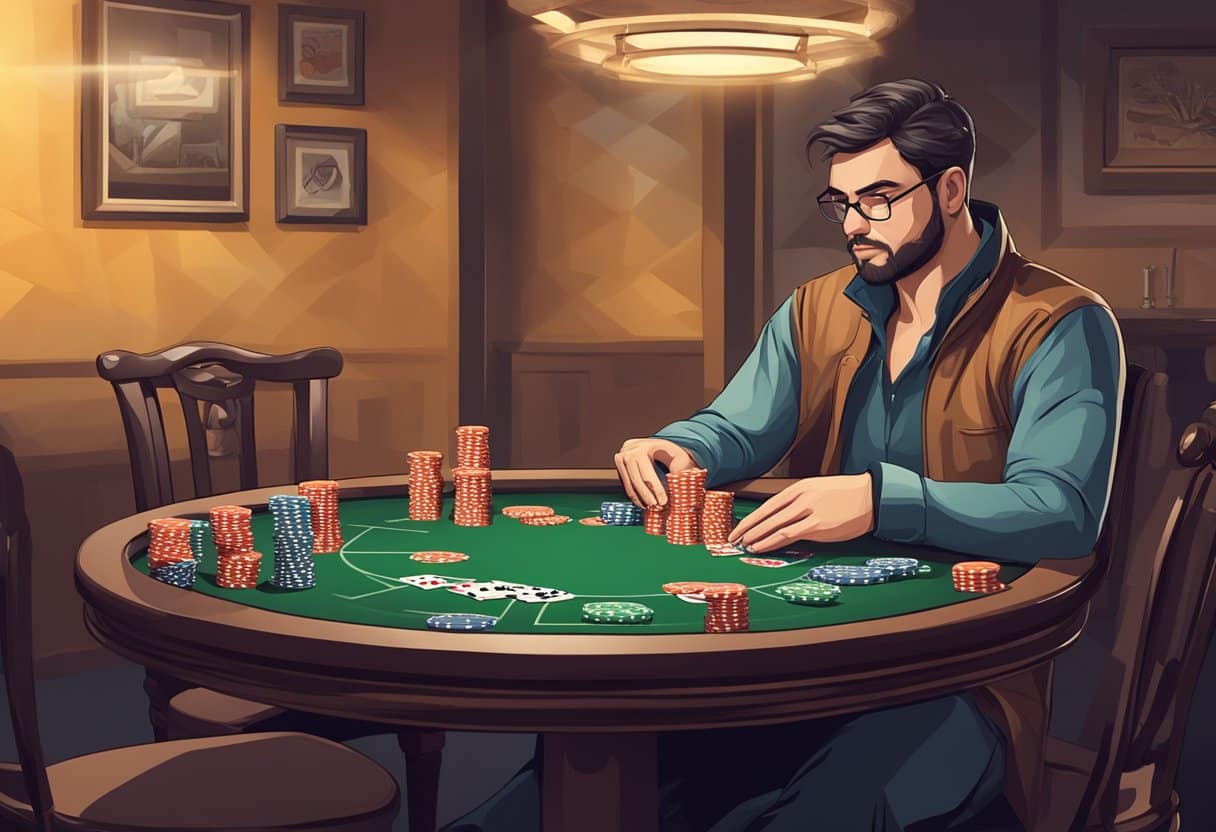Poker isn’t just about the cards you’re dealt—it’s about how you respond when luck isn’t on your side. In the poker world, “tilt” describes the emotional state where frustration and anger lead to poor decision-making at the table. Tilt is a dangerous mindset that causes players to abandon strategy in favor of emotion-driven plays, often resulting in significant losses and regrettable choices.

The psychology behind tilt reveals much about human nature under pressure. When players face bad beats or unexpected losses, their rational thinking can be overwhelmed by emotional reactions. This shift from calculated play to reactive behavior happens to amateurs and professionals alike, making tilt one of poker’s great equalizers.
Understanding your personal tilt triggers is the first step toward controlling this destructive state. Successful poker players develop awareness of their emotional responses and implement specific strategies to maintain focus when facing adversity. By recognizing the early warning signs of tilt, players can protect their bankroll and maintain the mental clarity needed for optimal performance.
Essentials of Poker Psychology

Poker psychology goes beyond just understanding the rules and odds of the game. It involves recognizing emotional states and mental patterns that affect decision-making at the table.
Defining Tilt
Tilt is a psychological state where emotions override rational thinking in poker. It typically happens after a player experiences a bad beat or a series of losses. When tilting, players make decisions based on frustration rather than strategy.
Signs of tilt include:
- Playing too many hands
- Making overly aggressive bets
- Chasing losses with risky plays
- Ignoring pot odds and probabilities
Tilt is dangerous because it leads to poor decision-making and lack of focus. Even professional players experience tilt, but they’ve developed techniques to recognize and manage it. These techniques include taking breaks, using breathing exercises, and maintaining proper bankroll management.
Players who understand tilt have an advantage over those who don’t. They can exploit opponents on tilt while protecting themselves from falling into this emotional trap.
The Role of Variance in Poker
Variance refers to the natural ups and downs in poker results that occur regardless of skill. Even perfect play will experience losing streaks due to the random distribution of cards.
Short-term results in poker often have little correlation with skill. A player can make the mathematically correct decision and still lose because of variance.
Types of poker variance:
- Positive variance: Winning more than expected based on skill
- Negative variance: Losing more than expected based on skill
- Natural variance: The expected statistical swings in results
Understanding variance helps players maintain emotional stability. When players recognize that short-term results don’t reflect skill, they’re less likely to tilt after losses. This psychological resilience is crucial for long-term success.
Recognizing Bad Beats and Bad Luck
A bad beat occurs when a statistically favored hand loses to an underdog hand. These moments test a player’s psychological fortitude more than any other aspect of poker.
Bad beats are inevitable in poker. The mathematical nature of the game guarantees that the best hand won’t always win. What matters is how players respond to these situations.
Constructive responses to bad beats include:
- Analyzing if the money went in with the best hand
- Accepting that good decisions can have bad outcomes
- Focusing on long-term results rather than individual hands
Players who can separate bad luck from bad play maintain clearer thinking. They avoid the common trap of attributing losses purely to luck while attributing wins solely to skill. This balanced perspective helps prevent tilt and improves overall performance.
Impact of Tilt on Decision-Making

Tilt fundamentally changes how poker players make decisions at the table. When emotions take over, logical thinking gets pushed aside, causing players to make choices they wouldn’t make in a calmer state of mind.
Short-Term vs. Long-Term Effects
The immediate effects of tilt include making impulsive bets, calling too frequently with weak hands, and overplaying marginal holdings. Players on tilt often chase losses by entering pots they should avoid.
In the short term, tilt might occasionally lead to lucky wins, giving players false confidence. This reinforces poor decision-making patterns.
Long-term effects are more damaging. Consistent tilt episodes deplete bankrolls and establish bad habits that become difficult to break. Studies show that players who frequently experience tilt have significantly lower win rates over time.
Tilt also damages your table image. Opponents quickly identify tilted players and target them for value bets, further compounding losses.
Tilt and Aggressive Play
Tilt often manifests as excessive aggression at the table. Tilted players frequently shift from strategic aggression to emotional aggression, which is easy for skilled opponents to exploit.
Common signs include:
- Raising with marginal hands
- Bluffing too frequently
- Overvaluing mediocre holdings
- Making oversized bets without proper pot odds
This aggressive play stems from a desire to “get even” or prove something rather than making mathematically sound decisions. The difference is crucial – strategic aggression is calculated, while tilt-driven aggression is emotional.
Players on aggressive tilt may experience temporary success if opponents fold to their increased pressure. However, observant players will adjust their strategy to call down lighter or re-raise more frequently.
Psychological Triggers and Frustration
Certain situations consistently trigger tilt in poker players. Bad beats (losing with statistically favored hands) rank as the primary cause, creating a sense of injustice that clouds judgment.
Other common triggers include:
- Running into multiple strong hands consecutively
- Missing draws repeatedly
- Being outplayed by specific opponents
- Time pressure or fatigue
Frustration builds when players feel the game is unfair or that they’re experiencing an unusual run of bad luck. This frustration activates the brain’s emotional centers, particularly the amygdala, which can override the prefrontal cortex responsible for logical decision-making.
Physical signs of frustration include increased heart rate, muscle tension, and difficulty concentrating. Recognizing these symptoms early is crucial for preventing full-blown tilt episodes.
Bankroll Management Strategies

Effective bankroll management is the foundation of sustainable poker play and helps prevent tilt situations from devastating your poker career. Smart management practices create a psychological safety net that allows players to make decisions based on strategy rather than fear.
Setting a Loss Limit
Loss limits are critical safeguards that protect players from emotional spirals. A well-defined loss limit tells you exactly when to walk away from the table, removing the need for in-the-moment decision making when emotions run high.
Most successful poker players set daily loss limits at 5-10% of their total bankroll. This specific boundary helps prevent catastrophic losses during a single session.
When you hit your predetermined loss limit, it’s time to stop—no exceptions. This rule becomes especially important after experiencing bad beats or when feeling frustrated.
Some players use a “stop-loss” tracking app or notebook to monitor their session progress. These tools create accountability and make it harder to justify “just one more hand” thinking.
The Importance of Stake Levels
Properly matching stake levels to your bankroll size creates psychological comfort that improves decision quality. The standard recommendation is having 20-30 buy-ins for cash games and 100+ buy-ins for tournaments.
Playing at appropriate stakes reduces anxiety about losing significant portions of your bankroll on any single hand. This mental freedom allows for better strategic thinking rather than fear-based play.
When your stakes feel comfortable, you’re less likely to experience tilt after losses. The financial pressure decreases, making emotional control easier to maintain.
Many professional players deliberately play at stakes below what their bankroll could support. This conservative approach prioritizes long-term sustainability over short-term profit maximization.
When to Move Up in Stakes
Moving up in stakes should be a carefully calculated decision based on both bankroll size and skill development. A good rule is to move up only when you have 25-30 buy-ins for the next level.
Signs you’re ready for higher stakes:
- Consistent profitability at current level for 50+ sessions
- Emotional control during both winning and losing periods
- Thorough understanding of strategies specific to your game format
- Bankroll that safely supports the new stake level
High stakes games intensify psychological pressure. Before moving up, honestly assess your mental game strength, not just your technical skills.
Taking shots at higher stakes should be limited to 1-2 buy-ins maximum. If unsuccessful, immediately return to your regular stakes to protect your bankroll and confidence.
Practical Techniques to Avoid Tilt
Controlling tilt requires specific strategies that focus on mental preparation, active management during play, and cognitive techniques for maintaining focus. These practical approaches can help poker players stay in control even when facing challenging situations.
Developing a Healthy Poker Mindset
The foundation of tilt control starts with proper bankroll management. Never play at stakes where losing would cause financial or emotional distress. This simple rule prevents one major trigger of tilt.
Set realistic expectations before each session. Understand that losing is part of poker, even with premium hands like pocket aces. Players who expect to win every hand with strong cards are setting themselves up for tilt.
Practice acceptance of variance. The mental game of poker requires recognizing that short-term results don’t always reflect skill level.
Keep a poker journal to track emotional patterns. Note situations that trigger negative emotions and develop specific counter-strategies for each trigger.
Use positive self-talk during sessions. Replace thoughts like “I always lose with pocket aces” with “Over time, strong hands will be profitable if played correctly.”
Effective Use of Breaks
Take scheduled breaks regardless of how the session is going. Regular 5-10 minute breaks every hour help maintain mental clarity and emotional control.
Implement a “stop-loss” system for emotions, not just money. If you feel early signs of tilt, immediately step away from the table for at least 15 minutes.
During breaks, use physical activity to reset. Even a short walk or some stretching can help release tension and clear your mind.
Practice deep breathing exercises during breaks. Simple box breathing (4 counts in, 4 counts hold, 4 counts out, 4 counts hold) can quickly calm your nervous system.
Consider ending sessions entirely when significantly tilted. Many players set rules like “no re-entries after losing with emotional reactions” to prevent playing while tilted.
Cognitive Exercises for Better Focus
Implement the “stop and think” technique. When facing a difficult decision, pause for 5-10 seconds to consider your options rationally rather than emotionally.
Practice mindfulness at the table by focusing completely on the present hand. Notice when your thoughts drift to past hands or results.
Use visualization before sessions. Imagine yourself responding calmly to bad beats or difficult situations before they happen.
Create a simple checklist for tough decisions. Ask yourself:
- What range of hands does my opponent likely have?
- What does my play look like from their perspective?
- Am I making this decision based on math or emotions?
Develop a personal “tilt switch” word or phrase. When you notice tilt building, mentally repeat your phrase to interrupt the emotional pattern and regain focus.
Understanding Online Poker Dynamics
Online poker creates a unique environment where tilt can develop differently than in physical casinos. The digital format changes how players experience emotions and manage their responses to bad beats or losing streaks.
Differences between Online and Live Poker
Online poker moves much faster than live games. Players see 2-3 times more hands per hour online, which means more opportunities to win—but also more chances to experience bad beats.
The absence of physical cues and face-to-face interaction removes important emotional feedback. Players can’t see opponents tilting or control their own visible reactions.
Multi-tabling (playing several tables at once) is only possible online. This increases the variance and potential for emotional swings in shorter timeframes.
Online games tend to be more aggressive. The anonymity and ease of clicking buttons rather than physically moving chips leads many players to take bigger risks.
The chat feature can become a source of tilt when opponents use it to taunt or “needle” after winning hands.
Managing Tilt in Online Play
Setting strict time limits helps control tilt in online poker. Unlike casinos where leaving requires physical effort, online players can simply click one more hand repeatedly when tilting.
Technical solutions can help manage emotions. Software like tilt blockers can force breaks after losing sessions or big pots.
Bankroll management becomes even more crucial online. Smart players never risk more than 5% of their total bankroll on any single table.
The “stop-loss” technique works well in digital environments. Decide before playing exactly how much you’re willing to lose, and stick to it strictly.
Physical separation from the game helps prevent tilt. Taking a 10-minute break away from the computer after a bad beat can reset your emotional state.
Many successful online players maintain session journals to track their emotional states and identify tilt patterns specific to digital play.
Case Studies and Professional Insights
Professional poker players offer valuable lessons in managing tilt and using psychology to gain an edge. Their experiences in high-pressure situations reveal practical strategies for emotional control.
Analyzing Professional Poker Players
Daniel Negreanu stands out for his exceptional emotional control at the table. When facing a bad beat, he often takes a deep breath and maintains his calm demeanor rather than letting frustration affect his next decisions.
Phil Ivey, nicknamed “the Tiger Woods of Poker,” demonstrates remarkable poker face consistency. His unchanging expression regardless of hand quality prevents opponents from gathering useful information about his cards.
Maria Konnikova, who transitioned from psychology writer to professional poker player, applies her background in cognitive psychology to her gameplay. She emphasizes the importance of recognizing cognitive biases that lead to poor decisions.
Key Trait of Successful Pros:
- Emotional regulation
- Consistent behavior patterns
- Understanding opponent psychology
- Quick recovery from setbacks
Learning from High-Stake Game Scenarios
High-stakes environments amplify psychological factors in poker. In the 2019 World Series of Poker Main Event, Hossein Ensan demonstrated remarkable tilt control when facing multiple all-ins against aggressive opponents. He maintained his strategy despite the pressure of potential million-dollar swings.
The mental game of poker becomes especially crucial in tournament bubble situations. Players who handle the stress of being close to money positions typically outperform those who become overly cautious or reckless.
One instructive case occurred during a high-stakes cash game when a player lost $200,000 in a single hand but continued playing optimally without signs of tilt. This exemplifies the professional mindset of treating each hand as an independent event.
Successful players also recognize when to take breaks. After suffering significant losses, many pros step away from the table to reset mentally rather than continuing to play while tilted.
Cultivating Resilience in Poker
Resilience in poker means bouncing back from losses and staying focused despite challenges. Players who build this skill can handle the emotional ups and downs of the game more effectively.
Key aspects of poker resilience:
- Accepting variance as part of the game
- Developing emotional control during bad beats
- Maintaining consistent decision-making under pressure
- Creating distance between emotions and actions
To build resilience, players should track their emotional responses to losses. This helps identify personal tilt triggers and creates awareness of when emotions begin affecting gameplay.
Taking breaks after difficult sessions can prevent tilt from carrying over into future games. Many professionals step away from the table for a few minutes when they notice emotional reactions beginning to influence their choices.
Practice exercises like deep breathing or mental reframing help players stay calm during stressful moments. These techniques create a buffer between feeling frustration and making poor decisions.
Resilient players understand that short-term outcomes don’t necessarily reflect skill. They focus on making correct decisions rather than results, knowing that variance evens out over time.
Building a support network of fellow players provides perspective during difficult periods. Discussing challenging situations helps normalize the experience of variance and offers new perspectives on handling tilt-inducing scenarios.


